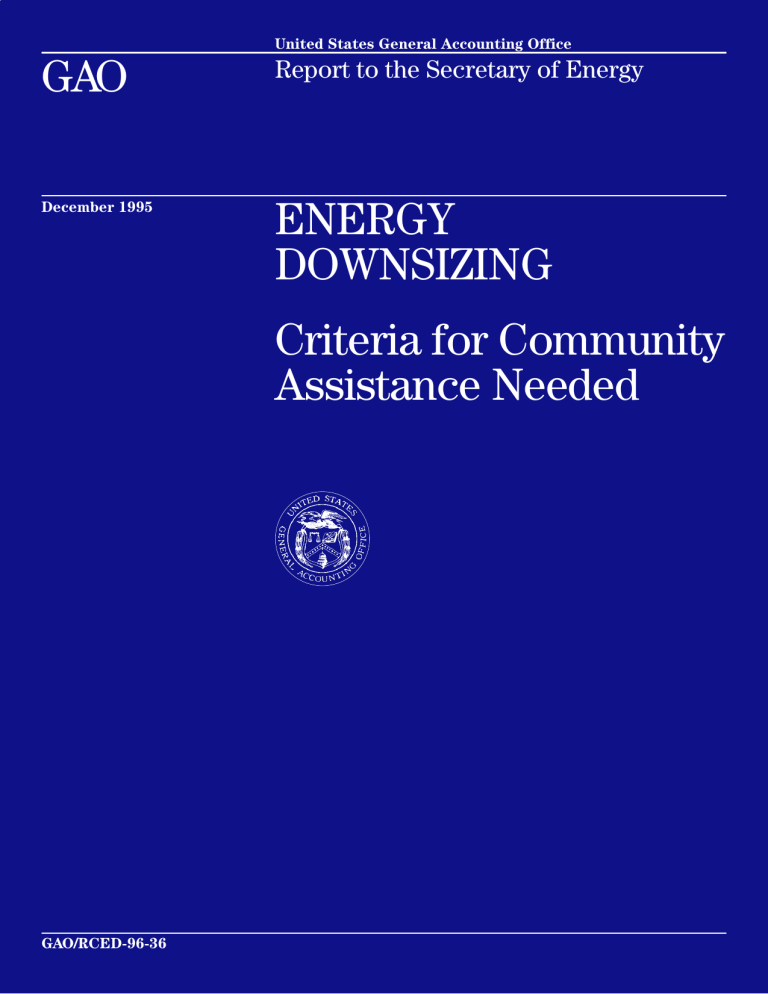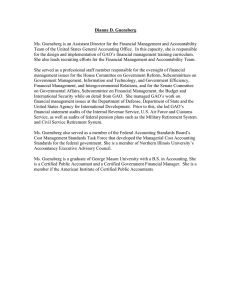GAO ENERGY DOWNSIZING Criteria for Community

GAO
December 1995
United States General Accounting Office
Report to the Secretary of Energy
ENERGY
DOWNSIZING
Criteria for Community
Assistance Needed
GAO/RCED-96-36
GAO
Results in Brief
Background
United States
General Accounting Office
Washington, D.C. 20548
Resources, Community, and
Economic Development Division
B-270358
December 27, 1995
The Honorable Hazel R. O’Leary
The Secretary of Energy
Dear Madam Secretary:
Since the end of the Cold War, the Department of Energy has been downsizing and realigning its facilities. As part of this effort, Energy closed the Pinellas plant, located on a 96-acre site in Largo, Florida. This facility had been used to manufacture components for the nation’s nuclear weapons program. In 1995, Energy transferred the facility to the Pinellas
County Industry Council 1 to help minimize the adverse economic effects of the closing on the surrounding communities. Energy has also provided funding to mitigate the effects of the closing.
Because Energy will likely dispose of additional facilities as it continues to downsize and realign its facilities, this report examines the criteria Energy used to (1) identify and evaluate the economic effects of closing the
Pinellas plant and (2) decide what types and amounts of assistance were appropriate to help offset these effects.
Energy’s policy guidance supports economic development to minimize the impact on displaced workers and affected communities of closing the
Department’s former defense nuclear weapons facilities. However, Energy has not established specific criteria for identifying and evaluating the impact of the closings; nor has it established specific criteria for deciding what types and amounts of assistance are appropriate to help offset that impact. Such criteria are important because Energy’s downsizing will likely continue for years and will cost millions of dollars.
As part of the nationwide effort to downsize, realign, or close defense nuclear weapons facilities, on September 8, 1993, the Secretary of Energy authorized the termination of defense production activities at the Pinellas plant in Largo, Florida. This decision was designed to reduce the cost of operating facilities that make components for the nation’s nuclear weapons complex. On December 14, 1993, Energy notified the Pinellas plant’s employees and the affected communities that the plant would be closed over the next several years as activities were consolidated at other
1 The Council is chartered by the state to, among other things, develop the county’s industrial base.
Page 1 GAO/RCED-96-36 Energy Downsizing
B-270358
Energy locations. On May 27, 1994, Energy issued a Workforce
Restructuring Plan identifying the actions it would take to minimize the impact of the closing on the displaced workers. Energy also developed an
Economic Development Plan in conjunction with representatives of the affected communities to identify the actions it would fund to minimize the impact of the plant’s closing on the surrounding communities.
Section 3161 of the National Defense Authorization Act for Fiscal Year
1993 (P.L. 102-484) requires Energy to develop a plan for restructuring the workforce at defense nuclear weapons facilities affected by a change in nuclear weapons production. The objectives of the plan should include identifying the types of assistance to displaced workers and affected local communities that Energy will provide to minimize the social and economic effects of its decisions to terminate nuclear weapons production operations.
The Pinellas plant is operated under contract by Lockheed Martin
Specialty Components, Inc. The plant employed 1,132 personnel on
March 25, 1994. On March 7, 1995, Energy transferred the Pinellas plant to the Pinellas County Industry Council to help mitigate the economic impact of the plant’s closing on the surrounding communities. The plant consists of about 96 acres of land and over 750,000 square feet of office and plant space. Two appraisals were performed to determine the value of the property, land, and facilities. The appraised values were $2.6 million and
$5.1 million. The site was sold to the Council for the lower appraised value of $2.6 million. As part of the sale, Energy agreed to finish cleaning up environmental pollution at the site. To accomplish this task, Energy is leasing the site back from the Council for up to 31 months at a rate of
$120,331 a month. The monthly lease payments are being credited against the sale price. After 22 months, the lease payments will have offset the sale price, and Energy will begin paying rent to the Council.
Pinellas County, the most densely populated county in Florida, is located in the Tampa Bay metropolitan statistical area, which is Florida’s largest metropolitan market. Pinellas County has a high percentage of high-technology and manufacturing jobs. However, tourism, real estate, and retail sales are the staple industries of the county’s economy, and growth is occurring in manufacturing, international trade, health care, and biotechnology. When the workforce’s restructuring began in 1994, the
Pinellas plant was the 21st largest employer in Pinellas County.
Page 2 GAO/RCED-96-36 Energy Downsizing
B-270358
Energy Lacks Criteria for Identifying and
Mitigating the Impact of Downsizing
Energy has issued policy guidance on the responsibilities of Energy and contractor officials for (1) mitigating the impact on communities of reductions in contractors’ employment at Energy’s facilities and
(2) supporting communities’ transition and economic development activities. However, this guidance does not establish specific criteria either for determining the economic effects of Energy’s downsizing or for funding communities’ economic development activities.
Energy Is Providing
Assistance to Mitigate the
Effects of Closing the
Pinellas Plant
Energy has relied on the local communities to help determine the types and amounts of assistance needed to mitigate the economic impact of closing the Pinellas plant and has not performed analyses to determine the extent of the impact and the amounts of assistance needed. However,
Energy is providing over $20.5 million in financial assistance. The Director of Energy’s Office of Worker and Community Transition told us that
Energy is further trying to mitigate the economic effects of the closing on the communities by seeking to convert defense technology to produce commercial goods and services. Energy’s guidance indicates that such commercialization will create jobs for former employees and enhance economic development. According to a Transition program official at
Energy’s Pinellas Area Office, Energy is providing $10.75 million for economic development activities to facilitate workers’ and the communities’ transition. In addition, Energy provided $9.75 million for alternative-use activities at the facility and technology transfer initiatives with Lockheed Martin Specialty Components, Inc. Finally, the Department of Defense is providing $6 million for technology development. The financial assistance has been provided to
•
•
•
•
• plan and organize the local community organization; identify replacement job opportunities for the Pinellas plant’s employees by creating new businesses, attracting businesses to the area, and expanding existing businesses; identify potential replacement occupants for the Pinellas plant; develop criteria for evaluating, ranking, and commercializing technologies; and establish a technology deployment center to make the Pinellas plant’s equipment, technical expertise, production capability, and service functions available for new economic and business development.
Page 3 GAO/RCED-96-36 Energy Downsizing
B-270358
Energy’s Guidance
Establishes Goals for
Assisting Workers and
Communities
Conclusions
In November 1992, Energy issued policy guidance stating that reductions in contractors’ employment should be managed to, among other things, help alleviate the impact of the reductions on affected communities. The guidance requires cognizant program secretarial officers, heads of field organizations, and contractors to develop programs to mitigate the impact of the reductions on the displaced employees and the communities.
In April 1993, Energy’s Office of Worker and Community Transition issued interim guidance on restructuring the Department’s contractor workforce to implement section 3161 of the National Defense Authorization Act for
Fiscal Year 1993. This guidance, which was revised in April 1995, addresses three interdependent processes that Energy considers integral to support economic development activities: involving local communities, allocating funding and resources, and identifying uses for Energy’s surplus real and related personal property. The guidance does not define what conditions create the adverse economic effects that require the transfer of
Energy’s land and facilities. Although the guidance states that Energy will prioritize funding for projects, it does not discuss the specific types and amounts of assistance that should be provided to offset the economic effects. Because Energy will likely continue downsizing its facilities at other locations, such criteria are needed to provide for the fair and appropriate allocation of its resources.
The Director of Energy’s Office of Worker and Community Transition agreed that the Department does not have specific criteria for identifying and evaluating the economic effects of closing its facilities and downsizing or for determining the appropriate types and amounts of assistance to help offset these effects. However, he told us that determining the reasonableness of such activities and assistance has involved negotiation between Energy and community stakeholders.
At the conclusion of our audit work, the Director told us that his office needs to develop specific guidance on how much Energy should spend to mitigate the economic effects of downsizing and to develop replacement technologies.
Because the actions at the Pinellas plant are only part of a longer-term restructuring process at Energy’s facilities, Energy will continue to spend millions of dollars to mitigate the adverse economic effects of downsizing on communities. However, without specific criteria for identifying and analyzing these effects in communities and for making decisions on
Page 4 GAO/RCED-96-36 Energy Downsizing
B-270358
Recommendation
Agency Comments and Our Evaluation
Scope and
Methodology
providing financial and other assistance for economic development,
Energy cannot ensure that it is fairly and appropriately allocating its resources.
We recommend that you direct the Director, Office of Worker and
Community Transition, and other cognizant secretarial officers to develop criteria for Energy to
•
• identify the adverse economic effects of downsizing or closing its facilities and define the types and amounts of assistance that it will provide for economic development.
We transmitted a draft of this report to the Secretary of Energy for review and comment. Energy’s comments appear in appendix I. Energy generally agreed with the report’s findings and recommendation. In addition, Energy outlined its plans for implementing our recommendation and provided some technical corrections. The conceptual framework outlined by Energy to implement our recommendation appears reasonable; however, Energy did not provide time frames for implementation. We believe that establishing time frames is important because, as Energy noted in its comments, the impact of future closings may be more severe and a well-defined program would be the most effective way to minimize that impact. Energy also explained why it had initiated the program without specific criteria to identify the adverse economic effects of downsizing or to define the types and amounts of economic development assistance that it would fund. We believe that specific criteria are important because they would help Energy allocate its resources fairly.
We reviewed Energy’s policies and procedures governing the sale of the
Pinellas plant to the Pinellas County Industry Council. We reviewed relevant federal regulations, prior
GAO
reports on sales of property, and a related audit report by Energy’s Inspector General. We reviewed cost analyses, property appraisals, financial documents, relevant departmental policies and procedures, and data on Energy’s transfers of properties through sales and leases to communities and businesses, as well as on the recipients’ uses of the properties. We interviewed Energy officials in the
Offices of Worker and Community Transition, Environmental
Management, Field Management, and the Pinellas Area Office. We
Page 5 GAO/RCED-96-36 Energy Downsizing
B-270358 conducted our review from June 1995 through November 1995 in accordance with generally accepted government auditing standards.
As you know, 31 U.S.C. 720 requires the head of a federal agency to submit a written statement of the actions taken on our recommendations to the
Senate Committee on Governmental Affairs and the House Committee on
Government Reform and Oversight not later than 60 days after the date of this letter. A written statement must also be sent to the House and Senate
Committees on Appropriations with the agency’s first request for appropriations made more than 60 days after the date of this letter.
We are sending copies of this report to your Audit Liaison Division for distribution within your agency. Copies will also be sent to congressional committees; the Director, Office of Management and Budget; and other interested parties. We will make copies available to others upon request.
Please call me at (202) 512-3841 if you or your staff have any questions.
Major contributors to this report were Jeffrey E. Heil and Carrie M.
Stevens.
Sincerely yours,
Victor S. Rezendes
Director, Energy and
Science Issues
Page 6 GAO/RCED-96-36 Energy Downsizing
Page 7 GAO/RCED-96-36 Energy Downsizing
Appendix I
Comments From the Department of Energy
Page 8 GAO/RCED-96-36 Energy Downsizing
Appendix I
Comments From the Department of Energy
(308681) Page 9 GAO/RCED-96-36 Energy Downsizing
Ordering Information
The first copy of each GAO report and testimony is free.
Additional copies are $2 each. Orders should be sent to the following address, accompanied by a check or money order made out to the Superintendent of Documents, when necessary. Orders for 100 or more copies to be mailed to a single address are discounted 25 percent.
Orders by mail:
U.S. General Accounting Office
P.O. Box 6015
Gaithersburg, MD 20884-6015 or visit:
Room 1100
700 4th St. NW (corner of 4th and G Sts. NW)
U.S. General Accounting Office
Washington, DC
Orders may also be placed by calling (202) 512-6000 or by using fax number (301) 258-4066, or TDD (301) 413-0006.
Each day, GAO issues a list of newly available reports and testimony. To receive facsimile copies of the daily list or any list from the past 30 days, please call (202) 512-6000 using a touchtone phone. A recorded menu will provide information on how to obtain these lists.
For information on how to access GAO reports on the INTERNET, send an e-mail message with "info" in the body to: info@www.gao.gov
PRINTED ON RECYCLED PAPER




